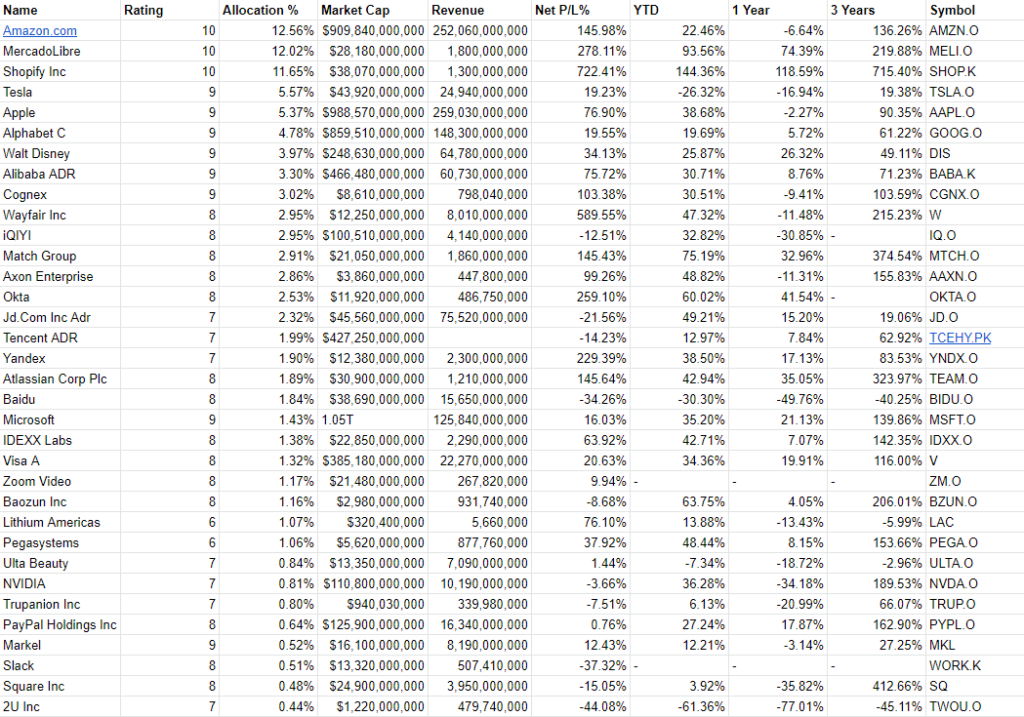Note: this post works best after you’ve developed a investing strategy. Here’s mine.
I’ve been investing in individual stocks for awhile now. I mentioned in my post above about how I invest that I am primarily invested in individual stocks. While I am still a huge proponent of investing money in index funds, I believe that with a well thought out strategy, one can beat the remarkable 8-9% average return of the stock market.
My approach for investing in individual companies is reliant on sustained discipline and consistent behaviors.
My goal is to invest my money in the very best companies. It isn’t to buy low and sell high. It isn’t to time the market and buy the dip. It isn’t to develop an algorithm or statistical analysis that tells me what to do. All of those things can work, but personally I don’t have the interest.
I believe that successful companies are likely to continue to be successful and to become more profitable as they optimize operations and leverage scale. I love the idea that I can be a part owner of the very best businesses. As a shareholder, the employees of those businesses are devoting their working lives to increase the value of your ownership. With this in mind, it’s become habitual for me to want to own more great companies.
As the world population grows and globalizes, there is more and more business being done. This means that winning companies can see their addressable markets grow simply from the increase in demand for goods and services. The four steps below are the mechanics of my methodology for choosing winning companies. Once we get through that, I’ll talk more about the philosophical components of my strategy, and how I identify new companies to potentially add to the list.
This is meant to be a working exercise – so I’ve attached my own worksheet that you can model off of as you read. I’d recommend making a copy for doing your own work.
1. Make a list of companies that you admire (Column A)
I start with a blank sheet and just start listing out the companies that create products, services, and experiences that I have found value in. I imagine my best version of the future (hat tip to David Gardner) – and think about what companies today are helping build that future. I try to think with a 20 year time horizon and stop once my list is about 20 companies. I do this annually, typically towards the end of the year so that I can plan my tax loss harvesting. If you’re having trouble thinking of names, just look around you! You’re surrounded by products and services that businesses have worked hard to create and sell to you.
2. Score, then rank the list (Column B)
Once I have my initial list of 20, I assign a 1-10 score to each company. I assign scores based on the confidence that I have in one simple statement. “I believe this company is the best place for me to invest my money because __________________. The better I feel about that hypothesis, the higher the score. I’d recommend actually writing down your fill in the blank there so that you can objectively analyze your thought process in the years to come.
3. Assign an allocation percentage (Column C)
Now that I have a ranked list of stocks, I sort by ranking, start at the top and fill in the percentage of my money that I’d like to invest in each company. I’m personally comfortable with a maximum of about 10% of my net worth invested in any single company and so that’s where I start. The higher the score, the larger the percentage. Make sure that this adds up to 100% and not more or less. You do not need to put a number next to all 20 of your picks. These will move on their own as the value of each investment changes, so I reevaluate my allocation annually.
Quite often when I do this exercise I remind myself that my 3rd best idea is a little better than my 4th best, a lot better than my 10th best, and a heck of a lot better than my 20th best. As a result I sometimes will have the last 5 or so on my list with less than a 2% allocation compared to a 10% on my best ideas.
4. Make the investments (Column D)
Once I’ve determined my allocation goals for each asset, I calculate the amount of money that that percentage represents. The easy way to do this is to put a formula into a cell that multiplies the amount of capital you have to invest against the percentage, then drag that down so you have that for the whole list. Once that’s complete, I set the orders in my brokerage accounts for the number of shares that it takes to invest the amount of money next to each stock.
Note: I’ve included my current portfolio with my personal ratings, allocation percentages, and Net profit/loss %, in addition to some company details including Market Cap (current value of the company), and performance this year to day (YTD), and over the last 1 and 3 year time frames. I’d recommend looking at these same metrics when evaluating investment opportunities just to set context.
My final sheet looks like this (sorted by allocation percentage):

Build a watch list
This is just a starter list of places to look. Hopefully you’ll quickly start to see the world in a way that surfaces great opportunities to you and find many more. Once you’ve made your investments, take your list and start adding to it! Here are some themes and ideas that I use to find new companies to add to my watch lists for future investment ideas.
Companies I’m a customer or user of
I find comfort in investing in companies that I’m familiar with. I spend most of my waking hours in front of a computer as a marketer at a tech company, and so many of my investment ideas come from the technologies that I interact with.
Companies that I’ve invested in that fit this bill include:
- Amazon
- Microsoft
- Shopify
- Apple
- Alibaba
- Okta
- Ulta Beauty Salon
- Visa
- Atlassian
- Wayfair
- Disney
- Pegasystems
- Nvidia
Proven models in new markets
By 2014 I had established some foundational positions in some of the strong domestic companies above. It was around that time that I came upon The Motley Fool. The Fool is one of the most refreshing sources of new investing ideas and principles I’ve encountered. It was through my consumption of their podcasts that I came upon a number of foreign companies building strong businesses based on the proven models of winners here in the US. The theme with many of the positions that I’ve opened in this category is, this is the (US-based company) of (non-US country). Investments in this category include:
- IQIYI (the Youtube of China)
- Mercadolibre (the Amazon of Latin America)
- Tencent (the Facebook/Blizzard/____________ of China)
- Alibaba (the eBay of China)
- Baidu (the Google of China)
- Baozun (the Shopify of China)
- Yandex (the Google of Russia)
- JD.com (the Amazon of China)
Best vision of the future
This is probably the third primary category of my investments. Companies in this category tend to offer innovative solutions to improve the world. Many of the companies in the two categories above also fit, or at least at one point fit in this category. These companies are looking to change the way that the world operates in their area. Investments in this category include:
- Match Group (online dating)
- Square and PayPal (payments)
- Axon (body cameras, tasers, and law enforcement case management software)
- Idexx Labs and Trupanion (pet care)
- Tesla (transportation, power)
- Cognex (machine vision)
- Two U (remote education)
I follow and am consistently inspired by a number of finance content creators including:
Podcasts
Newsletters
I hope that this was useful for you. Where are you in your journey? Did this inspire any questions or ideas? Share your sheet!

